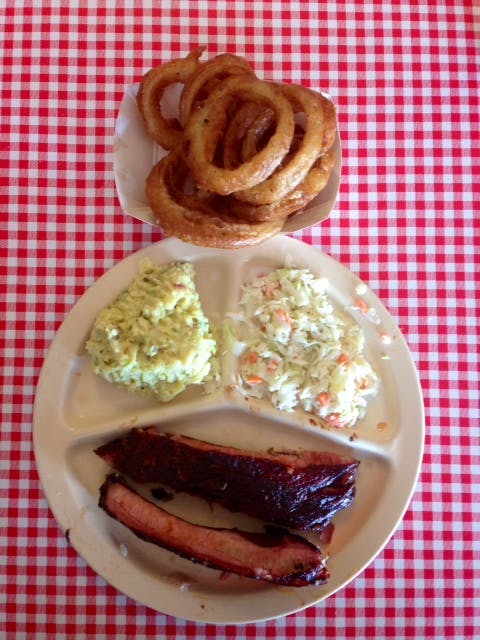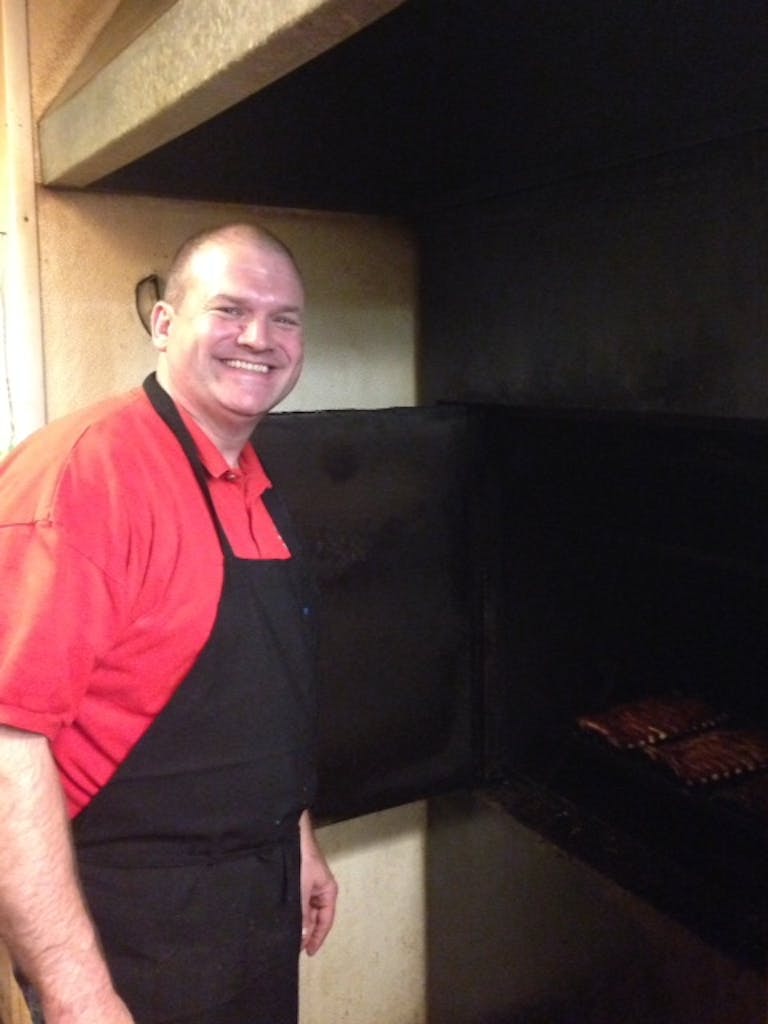 Owner/Pitmaster: David’s Barbecue; Opened 1988
Owner/Pitmaster: David’s Barbecue; Opened 1988
Age: 49
Smoker: Wood-fired Rotisserie Smoker
Wood: Hickory
Jimmy Harris doesn’t have much time for barbecue reviewers. “The real judge is that cash register.” And it hasn’t let him down for over two decades since he and his dad opened the place in Pantego. If you’re unfamiliar with Pantego, it’s a tiny municipality surrounded by the city of Arlington. The town is known for two things according to Harris. “Speed traps and bad water.” And it’s also know for having one of the last remaining connections to the Bryan Barbecue family – David’s Barbecue.
Jimmy’s father, David, and Sonny Bryan of Dallas barbecue fame were first cousins. Elias Bryan, who started a barbecue business in Dallas in 1910, was their grandfather. There are plenty of Sonny Bryan’s Barbecue locations around Dallas, but Sonny sold out to investors in 1989, shortly before his passing. That’s why David’s Barbecue is special. It’s the only joint left with a connection to Elias and Red Bryan that is still run by the family.
Daniel Vaughn: We’re here in Pantego, but where did you grow up?
Jimmy Harris: I’m an Arlington boy, but I was born in Oak Cliff. I was a year old when we moved here.
DV: What is your connection to the Bryan barbecue family?
JH: My great granddad was Elias Bryan. He started the barbecue business in 1910. He had four children, two boys and two girls. One of the girls was my grandmother, Mildred. The oldest was Red Bryan, and there was his brother Fred, and then Catherine.
DV: Was Elias the first of the Bryan family to come to Texas?
JH: Yes. He came to Oak Cliff. Oak Cliff was a thriving community. That’s where it was all happening.
DV: I saw that photo on the wall of Elias’s place. Where was it?
JH: It was on Jefferson and Beckley. He started in that building.
DV: How long was that restaurant in business?
JH: Until 1929. Red took over in ‘29.
DV: Then Red built a large building for his new restaurant, right?
JH: He built it in 1946. It was where El Ranchito is now [at Jefferson and Llewelyn]. Then he sold it to another barbecue place in 1956 or ’57. The Methodists and Baptists got together and voted Oak Cliff dry. He believed that if he couldn’t have barbecue with beer, he needed to move. Sonny opened his place in 1958, and that’s the reason he went across the river. Where he moved [to Harry Hines and Inwood], there was nothing there, but you could sell beer. He re-financed his house, and he and a buddy built that place. The first day he was open he didn’t even have electricity. Think about that. It would never happen today. He only had beef, ribs, and ham. Then there was cole slaw, beans, fries, and onion rings. That was it.
DV: Does it look any different today than it did back then?
JH: Not much. The last conversation I had with Sonny, I went over there with my dad. He wanted to replace this table in the middle of the place. When we went to move it we realized it was holding the ceiling up. His dad, Red Bryan, would walk into Sonny’s place and just shake his head. His place was a hole in the wall, and Red’s place down in Oak Cliff was a palace. Red had cattle hide on the booths.
DV: He even had a famous architect design it for him, Charles Dilbeck.
JH: Yes. It was the only restaurant he ever designed.
DV: It’s amazing that it’s still there.
JH: One of the reasons it’s still there is the unique look. His first place was the old tin shack. It was in an ideal location too. Across the street was Sears and the post office was just down the street. There was Sunset and Adamson High School.
DV: That menu he had was huge, too. There was a lot more than barbecue.
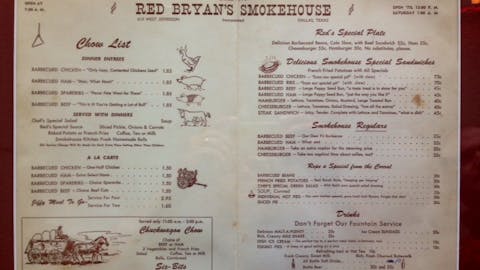
JH: That’s what drove him crazy. He was open from 7:00 in the morning until midnight. He was doing a good business, but…he was happier when he first started out.
DV: When Red opened his business, was he carrying on from his dad’s business or branching out on his own?
JH: Red actually started out as a florist. That didn’t work out, and he got into the barbecue business with his dad.
DV: I imagine he learned it all from Elias.
JH: Oh yeah. It was just like I learned from my dad. I started working when I was eight.
DV: Where were you working then?
JH: My dad, David Bryan Harris, bought one of the stores from Red Bryan on Collins [in Arlington].
DV: So, Red opened up other barbecue joints?
JH: Well, he shut down in Oak Cliff, and I think it was in the early sixties he started opening other stores. They were in Grand Prairie, North Dallas, Waxahachie, and in Arlington. The North Dallas store was on Lombardy.
DV: Do you remember Red having a line of pre-cooked and packaged barbecue in grocery stores?
JH: I do. He got some investors who were doing that. I don’t think it worked out. Do you want me to find out for you?
[Jimmy calls his dad, David]
JH: He said it was for a just a few years in the early sixties.
DV: Was your dad always in barbecue?
JH: No. He was a deputy sheriff for Bill Decker. He was the big sheriff back then. Red’s wife came to my dad and told him what he was doing was too dangerous and he needed to get into the family barbecue business. He bought the store in Arlington because they sold beer.
DV: Were your grandmother and grandfather ever in the barbecue business?
JH: At one time, everyone in the family was working in the barbecue business. They worked at the one in California a little bit.
DV: California? What was it called?
JH: Bryan’s Barbecue. It was in the Farmers Market in LA.
DV: What happened to the other Red Bryan’s Barbecue locations?
JH: They shut down in Waxahachie. The Grand Prairie location closed in the nineties. My dad had the opportunity to sell the property in 1985. He retired. Then, three years later he was bored and I had graduated college, so we opened up.
DV: That was here?
JH: Yes.
DV: What did you go to college for?
JH: Criminal Justice, then I got commissioned in the Army. I bought him out in ’92 after he got elected constable in Tarrant County.
DV: I saw the old menu from Red Bryan’s Barbecue hanging on the wall. It says barbecued beef on there, but never mentions brisket. Do you know if they were cooking brisket, or maybe beef navel?
JH: I don’t know for sure, but I bet they used navel. It was just a cheaper meat. It was just like brisket, but brisket keeps going up. It’s a “found” meat just like fajita meat. People are trying to do other things with brisket, or at least that’s what I hear. I don’t eat barbecue at other places.
DV: Why not?
JH: If I was to go in there, one of my customers would see me, and I’d be so embarrassed. I don’t want to be put in that situation.
DV: But you eat barbecue here a couple of times a day.
JH: I do.
DV: You haven’t gotten sick of it yet?
JH: Not yet.
DV: How have you seen barbecue change while you’ve worked here?
JH: You’ve got that past, and then the new places that are the future of barbecue, and I’m here in the middle of it in some sort of gray area. I’m hard to change. I’m stuck doing it the way my dad did it, but this new generation has a different perception of barbecue. You’ve got pork coming in, and nobody used to sell pork in Texas. Brisket has always been the mainstay. There are several cuts of brisket. There’s the 119 brisket with the deckle on [more on the definition of “deckle”]. Then there are the 120’s. That’s what everybody’s buying, but fifty years ago everybody in Dallas used 119’s. In Tarrant County they used the 120’s.
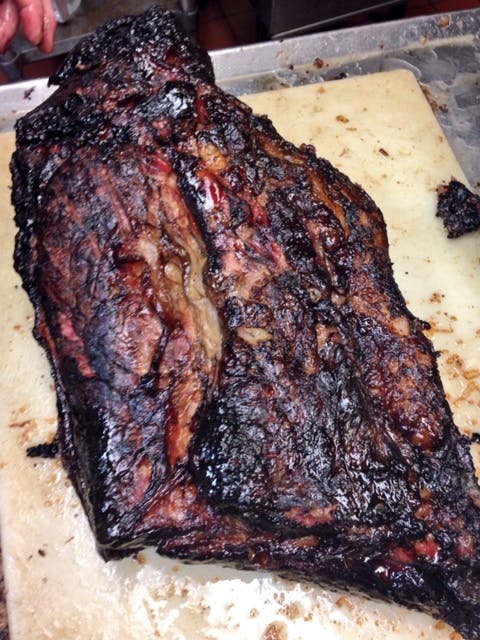
DV: It’s funny you mention that because I’ve heard of the “Angelo cut” [from Angelo’s in Fort Worth] which was a 120 trimmed just so.
JH: Yeah. Now nobody uses the 119, but we do. It costs me more because I have a little more waste, but it creates a better product.
DV: What are you paying for briskets these days?
JH: About $3.00 per pound.
DV: How big are they?
JH: About fifteen pounds. After we cook them and trim them, they’re about five pounds.
DV: How much do you charge per pound?
JH: I just went up last month after two and a half years. I’m at $12.99 per pound. That’s still low, but I can sell it at a cheaper price because I do so much of the work. I have less overhead.
DV: What kind of smoker do you cook them on?
JH: I’ve got a Bewley. There’s no electricity or gas. I use one of his rotisseries and one of the flat rack pits. I think we were one of the first families to use the rotisserie.
DV: How much do you cook every day?
JH: On a regular day we cook 800-1000 pounds of meat. On a busy day it’s 1200-1500 pounds.
DV: When do you get here?
JH: I walk through that door at 4:30am every day.
DV: How similar is the barbecue that you cook to what you’d have eaten at Red’s?
JH: I only know how similar it is to my dad’s. I learned from him, and he learned from Red. I think it’s very similar. The pits were a little different, but the potato salad, cole slaw, sauce, and brisket is all the same.
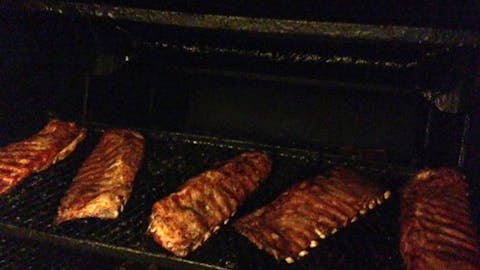
DV: And the sauce. What’s the secret to it? What’s in it?
JH: The sauce isn’t a secret. So many people have worked for our family and know it. It’s not that big a deal. We use lemons and onions. Lemons give you that unique taste instead of vinegar. The drippings from the brisket give you that smoke flavor. And then you have a ketchup base with a little brown sugar and some Worcestershire. That’s about it.
DV: That sauce and the cafeteria line with soft serve just seems to be a D/FW style of barbecue. Is that the way Red’s was too?
JH: Red went to the serving line in the sixties. The place in Oak Cliff had servers and counter service for to-go. I can turn the tables a lot faster with the cafeteria service. You can be in and out of here in twenty minutes. I think that’s why it’s so popular. Also having a wait staff just means more employees and more drama.
DV: How did you develop that onion ring recipe? They are so good.
JH: I don’t know. I just try something and let Jesse taste it. I’m not a chef. I’m a hash slinger.
DV: This a family business, but I’ve talked to a lot of pitmasters who don’t necessarily wish their profession on their children. Some are certainly drawn back, but do you see it that way too? That you want an easier life for your kids?
JH: That’s the truth. I have three daughters. Very rarely did they work down here. One of them graduated from college and two are finishing up. It’s not a hard business, but it’s such long hours. Then doing it every day, the same routine. Getting up at 4:00 in the morning. It’s a good thing that I have such a great wife who didn’t leave me. I’ve been blessed. I do have a fifth generation who’s interested. About a month ago, my nephew came back here after two tours in Afghanistan. I sat down with him and my dad, and I asked my dad, “Should we be honest with him and tell him not to get in this business?” My dad says “It doesn’t matter. He won’t believe us.” I don’t regret my life. I’ve got a good life, but you have your ups and downs. Right now is a really good time in my life. The biggest problem with so many of these restaurant people is this: They have one store and they’re happy, then they go get multiple stores. Most of these guys know barbecue, but once you branch out you’re not doing barbecue anymore. You’re dealing with lawyers and accountants.
DV: I’m guessing you still cook barbecue every day?
JH: Every day. And you know, there’s days that I love this business more than anything, but some days I’d just sell it on the spot for nickels.
DV: Most of these interviews I seem to be talking with someone in their sixties, but you seem like you’ve got plenty of good barbecue years left.
JH: I’ve got another fifteen or twenty years, I hope.


